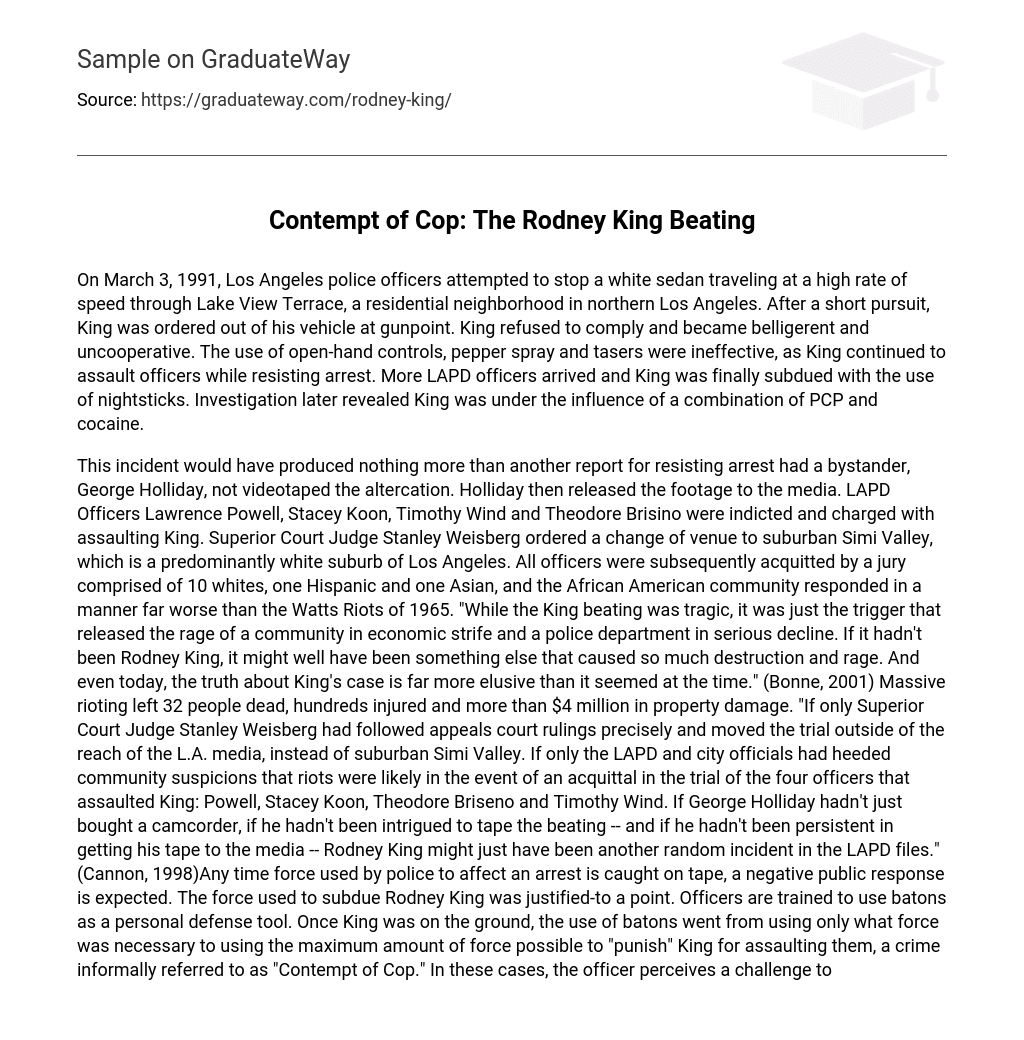On March 3, 1991, Los Angeles police officers attempted to stop a white sedan traveling at a high rate of speed through Lake View Terrace, a residential neighborhood in northern Los Angeles. After a short pursuit, King was ordered out of his vehicle at gunpoint.
King refused to comply and became belligerent and uncooperative. The use of open-hand controls, pepper spray and tasers were ineffective, as King continued to assault officers while resisting arrest. More LAPD officers arrived and King was finally subdued with the use of nightsticks. Investigation later revealed King was under the influence of a combination of PCP and cocaine. This incident would have produced nothing more than another report for resisting arrest had a bystander, George Holliday, not videotaped the altercation. Holliday then released the footage to the media.
LAPD Officers Lawrence Powell, Stacey Koon, Timothy Wind and Theodore Brisino were indicted and charged with assaulting King. Superior Court Judge Stanley Weisberg ordered a change of venue to suburban Simi Valley, which is a predominantly white suburb of Los Angeles. All officers were subsequently acquitted by a jury comprised of 10 whites, one Hispanic and one Asian, and the African American community responded in a manner far worse than the Watts Riots of 1965. “While the King beating was tragic, it was just the trigger that released the rage of a community in economic strife and a police department in serious decline.
If it hadn’t been Rodney King, it might well have been something else that caused so much destruction and rage. And even today, the truth about King’s case is far more elusive than it seemed at the time.” (Bonne, 2001) Massive rioting left 32 people dead, hundreds injured and more than $4 million in property damage. “If only Superior Court Judge Stanley Weisberg had followed appeals court rulings precisely and moved the trial outside of the reach of the L.A. media, instead of suburban Simi Valley. If only the LAPD and city officials had heeded community suspicions that riots were likely in the event of an acquittal in the trial of the four officers that assaulted King: Powell, Stacey Koon, Theodore Briseno and Timothy Wind. If George Holliday hadn’t just bought a camcorder, if he hadn’t been intrigued to tape the beating — and if he hadn’t been persistent in getting his tape to the media — Rodney King might just have been another random incident in the LAPD files.” (Cannon, 1998)Any time force used by police to affect an arrest is caught on tape, a negative public response is expected.
The force used to subdue Rodney King was justified-to a point. Officers are trained to use batons as a personal defense tool. Once King was on the ground, the use of batons went from using only what force was necessary to using the maximum amount of force possible to “punish” King for assaulting them, a crime informally referred to as “Contempt of Cop.” In these cases, the officer perceives a challenge to authority, such as fleeing, fighting or failure to obey officers’ orders, and acts to regain control. Prior to 1991, Rodney King had been arrested 22 times for various offenses including robbery, selling narcotics and assault. Since 1991, and after being awarded $3.8 million in a civil suit against the City of Los Angeles, King has been arrested nine times for domestic assault and various narcotics violations.
King is currently bankrupt and living in a drug rehabilitation facility in Los Angeles. Rodney King is no exemplary member of society; however, that does not excuse the officers’ use of force after it was no longer necessary, even if King was guilty of “Contempt of Cop.” Police officers are employed to enforce the law and arrest those who violate it, not punish those who question authority. REFERENCESBonne, J.E. (Writer), & Smits, L.D. (Director). (2001) The Rodney King Beating: 10 Years Later.
Ramsey, D.A. (Producer) Anatomy of a Crime. Court T.V. Cannon, L.F. (1998). Rodney King’s Legacy.
Retrieved June 19, 2005, from http://www.courttv.com/archive/casefiles/rodneykingCannon, L.F. (1998). Official Negligence: How Rodney King and the Riots Changed Los Angeles and the LAPD. Washington D.C.: CrownKoon, S.D. (1992).
Presumed Guilty: The Tragedy of the Rodney King Affair. Washington D.C.: Regenery





